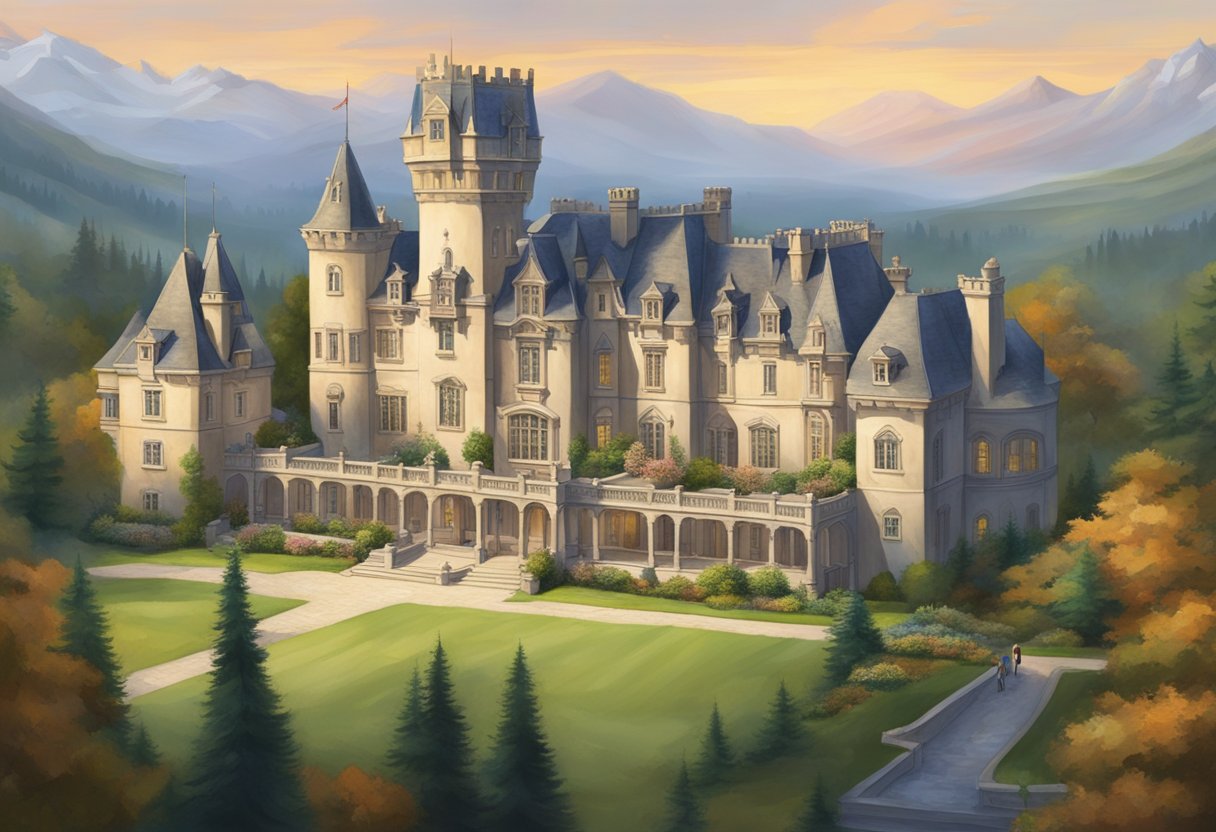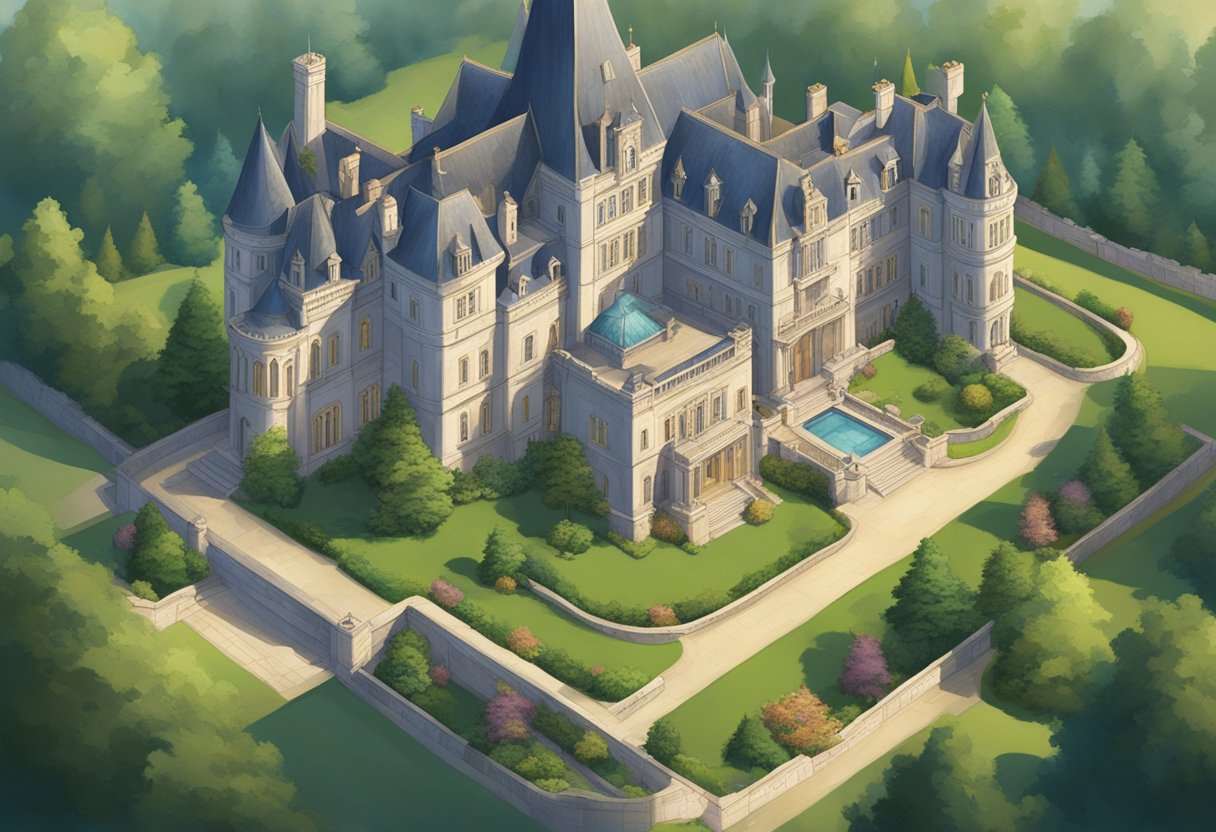When it comes to grand residences that have stood the test of time, castles and mansions each occupy their own revered place in architecture and social history. Castles, with their fortified walls and battlements, conjure images of medieval battles and royal dynasties, often sprawling over vast lands.
These stone-clad leviathans were designed to assert dominance and provide defense. On the other side of the spectrum, mansions, though significant in size and luxury, are generally seen as opulent private residences brimming with aesthetic appeal rather than military might.

Size, however, is a matter of perspective and purpose. Castles were built to accommodate armies, protect inhabitants, and serve as administrative hubs, hence they needed more space. Mansions, despite their sometimes sprawling estates and numerous rooms, were ultimately designed for living rather than withstanding sieges.
When imagining castles, you might think of the imposing walls of Prague Castle or the fairy-tale turrets of Neuschwanstein, while mansions evoke images of the extravagant Hearst Castle or the quintessential English luxury of a Georgian manor.
Key Takeaways
- Castles are emblematic of historical fortifications and power, often larger in scale.
- Mansions signify wealth and residential opulence but are typically smaller than castles.
- Comparing castles and mansions highlights different purposes—defense versus domestic luxury.
The Majesty of Castles
Castles are more than just old piles of stone; they are historical heavyweights and architectural goliaths wrapped in an impressive package of defensive measures.
They have stood as symbols of power and safety throughout history, far surpassing the average mansion in stature.
Historical Significance
In Europe, the Middle Ages were like a long-running reality show featuring kings, lords, and the occasional power-hungry bishop vying for the spotlight. Castles weren’t just homes; they were the center stage for history’s grand dramas.
They housed royalty and were often the hotspots for political intrigue and lavish court life.
- Kings and queens had their royal rendezvous here.
- Bishops and lords pulled the strings of power within these walls.
Architectural Marvels
These aren’t your standard two-up, two-down abodes; castles are testament to the creative prowess of their time. They exhibit staggering complexity and diversity in architecture, from the heights of towering turrets to the depths of dank dungeons.
- Turrets: Not just for a better view—it’s where archers had a field day.
- Keep: The original panic room for medieval VIPs.
Fortifications and Defenses
When it came to war, castles weren’t playing around. They were the tanks of the Middle Ages, equipped with everything a good defense requires. Drawbridges weren’t there just for dramatic entrances; they were the original “talk to the hand” to unwelcome visitors.
Moats were the watery hurdles for any would-be castle-crasher.
- Thick Walls: Perfect for whispering secrets and withstanding sieges.
- Battlements: The chessboard for soldiers, minus the calm deliberation.
From the imposing gatehouse to the drawbridge that went up faster than a nobleman’s ego at a jousting tournament, castles were about as impregnable as a hedgehog in a ball. They were the fortresses that laughed in the face of danger (and at the poor souls stuck outside during a siege).
Mansions: Homes of Luxury
In the realm of opulence, mansions stand as grandiose statements of wealth and architectural splendor, showcasing everything from gold-laced décors to sprawling gardens.
Modern Displays of Wealth
Today’s titans of industry and celebrities often choose luxurious mansions to flaunt their wealth. The splendor of these residences isn’t just in their size; it’s also in the details:
- Biltmore Estate: Nestled in Asheville, North Carolina, this mansion boasts a staggering 178,926 square feet of space, making it the largest privately-owned home in the United States.
- Hearst Castle: Magnate William Randolph Hearst commissioned architect Julia Morgan to design this San Simeon property, a testament to both opulence and Hearst’s fondness for the extravagant.
Design and Comfort
While mansions certainly scream wealth, they also whisper comfort. Great architects like Horace Trumbauer understood this delicate balance:
- Gold Accents: Homages to affluence, subtle or bold, are a common sight—gold doorknobs to gold-leaf ceilings.
- Temporary Homes?: Despite their size, some mansions, like Shadow Lawn, have transitioned from private residences to academic buildings, proving that comfort can be repurposed.
These architectural marvels are more than just homes—they are monuments to luxury living and the rich tapestry of American wealth.
Comparing Sizes: Castles vs. Mansions
When it comes to residential premiums, castles and mansions compete in their own heavyweight division. These grandiose abodes, historical and modern marvels of architecture, aren’t one to shy away from a little size comparison.
Let’s shed some light on the size differences between castles, which have housed kings and warriors, and mansions, which have been the humble abodes of millionaires and celebrities.
Castles traditionally served as fortified structures, often with enough room to house an entire army, let alone a royal family. Take for example the sprawling elegance of Prague Castle, which holds the Guinness World Record for being the largest coherent castle complex in the world.
It’s a tough standard to beat. Then there are others like Windsor Castle, the favored weekend residence of the British Royal Family, and the stoic Edinburgh Castle, perched high above the Scottish landscape.
| Castle Name | Location | Approximate Size |
|---|---|---|
| Prague Castle | Prague | 70,000 m² |
| Windsor Castle | England | 54,835 m² |
| Edinburgh Castle | Scotland | Notorious (size varies by source) |
Moving from stony battlements to luxurious estates, mansions are known for their grandiosity but favor residential comfort over military defense. Sizes can be substantial, but they generally don’t rival their fortified forebears.
However, certain mansions, such as Buckingham Palace, serve as both home and ceremonial headquarters. It’s a palace, yes, but its size and function align with that of a grand mansion, fit for Britain’s monarchs.
Mansions don’t generally pull a ‘castle’ move by spanning tens of thousands of square meters, but they often boast multiple rooms with leading-edge amenities, which can be as charming as castles with their own historical flair.
Consider the impressive Biltmore Estate in the United States – it’s no small contender in the square footage stakes.
So, where do castles and mansions land in the size spectrum? Castles often edge out with their colossal, community-sized layouts, but mansions are the modern titans of residential luxury, offering a cozier, yet still expansive charm.
Either way, anyone looking to play hide and seek will have a field day – it may just take a few weeks to find everyone.
Function and Status: A Symbolic View

In the grand game of architectural one-upmanship, castles and palaces have long been the playing cards of the elite, from monarchs to nobles. Their purpose? More than mere homes—they’re the ultimate flex in stone and tapestry.
- Castles: Sturdy bunkers with ramparts and crenellations, where monarchs and military leaders once peered over battlements, ready for the next siege.
- Palaces: These are the opulent cousins of the castle; think less “drawbridge defense” and more “drawn curtains for privacy.”
England knows how to put a castle to work. They’re not just for ruddy-faced monarchs shouting, “Off with their heads!” Nope, they’re symbols of power and rule, majestically towering over cities like London, drawing visitors as modern-day attractions.
Let’s play a game of “find the queen” in palaces: grandiose dwellings where every room screams, “A royal has nibbled scones here!” If the walls of Buckingham Palace could talk, they’d probably never stop boasting.
Japan takes a different approach. Their castles, like the famed residents of the Forbidden City, balance offense with Zen-like tranquility. It’s like saying, “Come for the cherry blossoms, stay because the samurai looks menacing.”
| Location | Structure | Function |
|---|---|---|
| Scotland | Castles | Defend, Dwell |
| France | Versailles | Flaunt, Party |
| Middle East | Palaces | Govern, Impress |
Finally, palaces like Versailles, less “castle” and more “nation’s fancy living room,” become museums, hanging on to their glory days with velvet ropes and gift shops. In contrast, the National Palace in the Middle East might still buzz with ministers and offices, proving that some palaces don’t just retire; they get a day job.


Leave a Reply